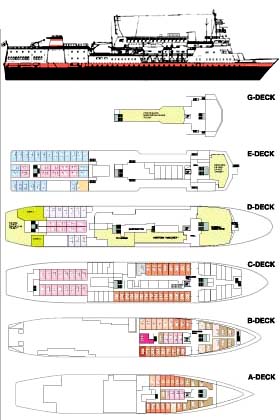History of the Hurtigruten
The Coastal Express
In 1891, August Kriegsman Gran, the
national steam ship advisor, came up with the idea of providing an express shipping
service between Trondheim and Hammerfest. Two steamship companies, The Nordenfjeldske
Dampskibsselskab and the Bergenske Dampskibsselskab, were offered the route, but rejected
it, regarding the sailing during the dark and stormy winters as impossible. At the time
there were only two marine charts in existence and only 28 lighthouses north of Trondheim.
Vesteraalens Dampskibsselskap, a relatively young steamship company based in Stokmarknes,
took up the challenge. For some time, Captain Richard With and his pilots had been keeping
accurate notes on courses, speeds and times taken to sail the route and felt that the
service would be viable.On 18th May 1893, the government entered into a 4-year contract
with Vesteraalens Dampskibsselskap, providing the company with the backing for a weekly
sailing between Trondheim and Hammerfest during the summer and Trondheim and Tromsø
during the winter. There were nine ports of call on the route.
When the steamship 'Vesteraalen' left the quay in
Trondheim on the morning of 2nd July 1893 bound for Hammerfest, it signalled the beginning
of a communications revolution. It enabled the population and industries along the coast
to communicate in a completely new way.
Previously, it could take up to three weeks in the summer or five months in the winter to
send a letter from Trondheim to Hammerfest. The Coastal Express reduced this time to a few
days.
After 36 hours the ship reached Svolvær, and on the 5th of July at 3.30am, 67 hours after
departing Trondheim, the ship docked at Hammerfest - half an hour ahead of schedule! The
ship and its crew were met by cheering crowds at all ports of call along the Norwegian
coast.
When Richard With and Vesteraalens Dampskibsselskab led the way, several other shipping
companies followed in their wake. In 1894 the Bergenske Dampskibsselskab and the
Nordenfjeldske Dampskibsselskab were licensed to run the Coastal Express route. The
service underwent continual improvements.
In 1898 Bergen became the southernmost port on the route. Vadsø was added to the Coastal
Express route in 1907, and Kirkenes followed in 1914. For a brief period there was a
weekly departure from Stavanger, but from 1936 to the present day there have been daily
departures from Bergen - only interrupted by the war years.
Over 70 ships have served in the Coastal Express fleet over the last century. The first
were acquired from other services both at home and abroad.
As time went by ships were built specifically for the Coastal Express route, with amongst
other facilities: cold storage and freezer rooms, roll on/roll off capability, storage
designed for goods stacked on pallets, vehicle transportation, course and conference
facilities.
From the very beginning it was believed that the economics would be based on tourism.
Brochures were created in several languages informing both sales offices and individual
customers abroad of the Coastal Expresses route along the wild and beautiful Norwegian
coast.
The Coastal Express made places like Lofoten, Trollfjorden, Skjærvøy, Hammerfest and the
North Cape available to the international public keen to experience the Land of the
Midnight Sun. And the tourists obliged - in abundance - making the Coastal Express one of
Europe's most famous attractions.
Today, the journey is internationally recognised as 'The Worlds Most Beautiful Voyage'
|
|
|
|
|
M/S Midnatsol
|
|
|
|
|
 |
|
|
|
|
Operator:
Constructed:
Modernised
No. of berths:
Max.no. passengers:
Max. no. cars:
Gross tonnage:
Length:
MetresWidth:
MetresSpeed:
|
TFDS, Tromsø
1982
1988/95
325
550
40
6.100
108,6 m
16,5 m
18 knop
|
|
|
 |
|
|
|
|
|
The "Polar Viewing Lounge" on deck F |
|
|
|
 |
|
|
|
|
|
Inner double-cabin (I2) with 2 berths and
sofa |
|
| Cabin classifications aboard M/S Midnatsol |
| Q2 |
Mini suite |
Outer mini suite, double-bed |
Deck E |
| J2 |
Cabin* |
Inner double-cabin, 2 berths and sofa |
Deck B |
| T2 |
Cabin |
Outer double-cabin, 2 berths and sofa |
Deck E |
| S2 |
Cabin |
Outer double-cabin, 2 berths and sofa |
Decks B, C, D and E |
| I2 |
Cabin |
Inner double-cabin, 2 berths and sofa |
Decks C, D and E |
| A2 |
Cabin |
Outer, double-cabin with 2 bunks |
Decks A, B and C |
| A3 |
Cabin |
A2 + 1 bunk |
|
| A4 |
Cabin |
A2 + 2 bunks |
|
| B2 |
Cabin |
Inner, double-cabin with bunks |
Decks A, B and E |
| B3 |
Cabin |
B2 + 1 bunk |
|
| |
* Cabins classed J are slightly larger than T,
S and I |
|
|
 |
|
|
|
|
4-bunk cabin (A4) on decks A, B and C |
|







